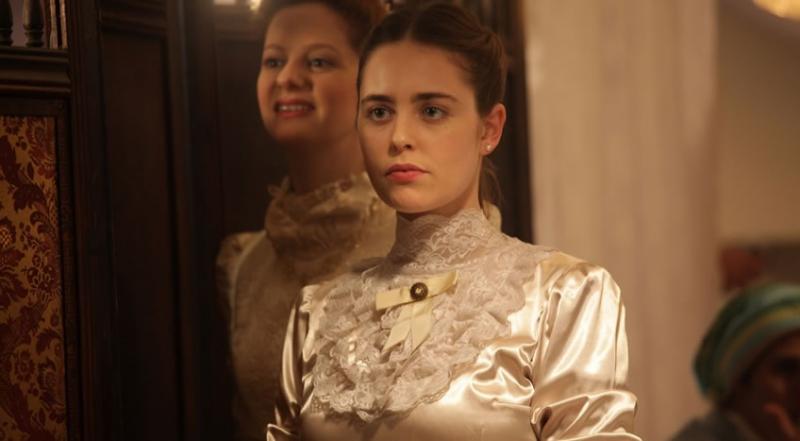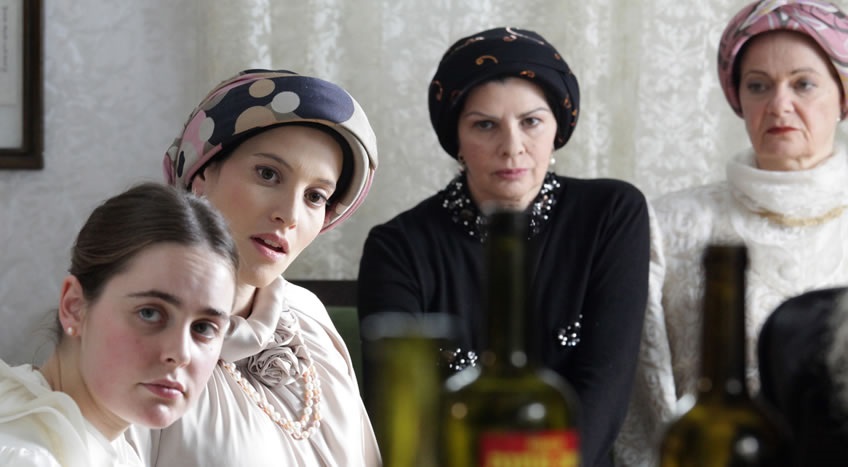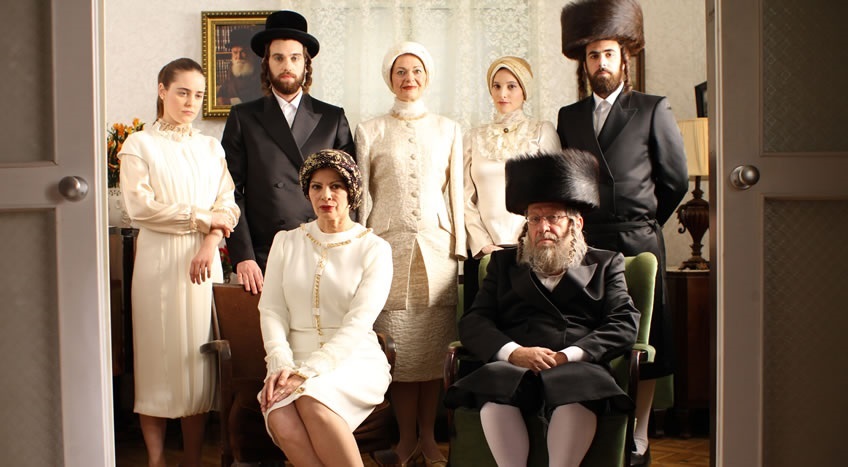Fill the Void | reviews, news & interviews
Fill the Void
Fill the Void
Memorable marriage drama set within Tel Aviv Hasidic community

It’s usually documentary cinema that takes us inside societies of which we know little, revealing their structures and rituals. Occasionally feature films achieve something similar, and Rama Burshtein’s Fill the Void is one such, telling its story from inside the world of Israel’s Orthodox Hasidic community, specifically the Haredim.
So it might seem surprising that one of the first comparisons critics have been making has been with the fiction of Jane Austen (Burshtein herself has acknowledged such resemblances, too). On reflection, it's nothing of the sort: both the film and the novels show women in convention-bound societies, where marriage is negotiated and managed as much through social structures as through love. (Admittedly, it posits the rather unfashionable concept for today that a woman’s position is defined principally through marriage, while those who remain single are in some way eccentric. If you’re looking to learn more about those who “transgress” the rules of such Orthodox worlds, namely its gay community, Sandi Simcha DuBowski’s marvellous documentary Trembling Before G-d from a decade ago remains unsurpassed).
 Fill the Void opens with the holiday of Purim, a time of generosity (and copious wine-drinking) in the family of 18-year-old heroine Shira (the marvellously innocent Hadas Yaron, main picture above). It’s a world in which the men, bearded and in black, elaboratedly behatted, sit around the table, led by the rabbi father of the family Aharon (Chaim Sharir), with the women at one side of the room, centred on the mother, Rivka (Irit Sheleg, pictured right, in centre). No black tones for them, though, but rather whites and restrained blues and greens, luminously shot by cinematographer Asaf Sudry, whose work is a treat throughout.
Fill the Void opens with the holiday of Purim, a time of generosity (and copious wine-drinking) in the family of 18-year-old heroine Shira (the marvellously innocent Hadas Yaron, main picture above). It’s a world in which the men, bearded and in black, elaboratedly behatted, sit around the table, led by the rabbi father of the family Aharon (Chaim Sharir), with the women at one side of the room, centred on the mother, Rivka (Irit Sheleg, pictured right, in centre). No black tones for them, though, but rather whites and restrained blues and greens, luminously shot by cinematographer Asaf Sudry, whose work is a treat throughout.
Marital happiness in this world, we feel, is something achieved in the process
Shira’s elder sister Esther, nine months pregnant, is there with her husband, Yochay (Yiftach Klein), also a rabbi. Tragedy strikes when she's taken ill and dies giving birth to a son, plunging the family into profound grief. The film may not have the best title in the world, but it does resound in the sense that this is a story about grief itself, seen especially through Rivka’s perspective, with actress Sheleg’s remarkable face enormously eloquent in its sadness.
In the more immediate, even pragmatic sense, the void to be filled involves finding a new wife for Yochay. In this society these things aren’t dictated – rather the surrounding community has an expectation that he will remarry, and possible candidates are already being sought, among them a widow from Belgium. The prospect of her grandchild going so far away would break Rivka’s heart again, so she’s desperate to find an alternative, including the idea that Shira should assume her dead sister’s position.
 The fact that it isn’t an arranged marriage, but rather one where the final decision will be made by the young couple themselves gives Burshtein’s film enormous sensitivity: its moments of silence resound as powerfully as any words in the script. The couple respect the considerations of those around them, and their betrothal would of course resolve the difficult situation. Marital happiness in this world, we feel, is something as much achieved in the process, as driven by love, though that's a factor, too: one of Shira’s most poignant realizations is that if she does marry Yochay, she will never experience that sense of revelatory first love that her sister had felt for him (and he for her).
The fact that it isn’t an arranged marriage, but rather one where the final decision will be made by the young couple themselves gives Burshtein’s film enormous sensitivity: its moments of silence resound as powerfully as any words in the script. The couple respect the considerations of those around them, and their betrothal would of course resolve the difficult situation. Marital happiness in this world, we feel, is something as much achieved in the process, as driven by love, though that's a factor, too: one of Shira’s most poignant realizations is that if she does marry Yochay, she will never experience that sense of revelatory first love that her sister had felt for him (and he for her).
It’s an enormously subtle process – significant, too, that the most senior rabbi, who becomes involved in the negotiation process, is as concerned as anyone else that Shira makes up her own mind. Though it’s a drama of considerable seriousness, Fill the Void is leavened with elements of passing, sometimes eccentric humour, and has a richly scored sound track (Shira herself plays the accordion). Though it’s set predominantly in interiors (in fact, it’s a story that could work on the stage), the choice of Tel Aviv as a location allows us to see this community, with its strict dress codes (family portrait, above left) coexisting within a wider secular society. Burshtein herself belongs to an ultra-Orthodox Hasidic community – her film work before Fill the Void, her debut feature, was intended for those within that community alone (whatever that may actually mean) – but she works here with secular actors, a fact which surely gives an extra resonance of complexity to an already original film.
rating
Explore topics
Share this article
The future of Arts Journalism
You can stop theartsdesk.com closing!
We urgently need financing to survive. Our fundraising drive has thus far raised £49,000 but we need to reach £100,000 or we will be forced to close. Please contribute here: https://gofund.me/c3f6033d
And if you can forward this information to anyone who might assist, we’d be grateful.

Subscribe to theartsdesk.com
Thank you for continuing to read our work on theartsdesk.com. For unlimited access to every article in its entirety, including our archive of more than 15,000 pieces, we're asking for £5 per month or £40 per year. We feel it's a very good deal, and hope you do too.
To take a subscription now simply click here.
And if you're looking for that extra gift for a friend or family member, why not treat them to a theartsdesk.com gift subscription?
more Film
 Steve review - educator in crisis
Cillian Murphy excels as a troubled headmaster working with delinquent boys
Steve review - educator in crisis
Cillian Murphy excels as a troubled headmaster working with delinquent boys
 Can I get a Witness? review - time to die before you get old
Ann Marie Fleming directs Sandra Oh in dystopian fantasy that fails to ignite
Can I get a Witness? review - time to die before you get old
Ann Marie Fleming directs Sandra Oh in dystopian fantasy that fails to ignite
 Happyend review - the kids are never alright
In this futuristic blackboard jungle everything is a bit too manicured
Happyend review - the kids are never alright
In this futuristic blackboard jungle everything is a bit too manicured
 Robert Redford (1936-2025)
The star was more admired within the screen trade than by the critics
Robert Redford (1936-2025)
The star was more admired within the screen trade than by the critics
 Blu-ray: The Sons of Great Bear
DEFA's first 'Red Western': a revisionist take on colonial expansion
Blu-ray: The Sons of Great Bear
DEFA's first 'Red Western': a revisionist take on colonial expansion
 Spinal Tap II: The End Continues review - comedy rock band fails to revive past glories
Belated satirical sequel runs out of gas
Spinal Tap II: The End Continues review - comedy rock band fails to revive past glories
Belated satirical sequel runs out of gas
 Downton Abbey: The Grand Finale review - an attemptedly elegiac final chapter haunted by its past
Noel Coward is a welcome visitor to the insular world of the hit series
Downton Abbey: The Grand Finale review - an attemptedly elegiac final chapter haunted by its past
Noel Coward is a welcome visitor to the insular world of the hit series
 Islands review - sunshine noir serves an ace
Sam Riley is the holiday resort tennis pro in over his head
Islands review - sunshine noir serves an ace
Sam Riley is the holiday resort tennis pro in over his head
 theartsdesk Q&A: actor Sam Riley on playing a washed-up loner in the thriller 'Islands'
The actor discusses his love of self-destructive characters and the problem with fame
theartsdesk Q&A: actor Sam Riley on playing a washed-up loner in the thriller 'Islands'
The actor discusses his love of self-destructive characters and the problem with fame
 Honey Don’t! review - film noir in the bright sun
A Coen brother with a blood-simple gumshoe caper
Honey Don’t! review - film noir in the bright sun
A Coen brother with a blood-simple gumshoe caper
 The Courageous review - Ophélia Kolb excels as a single mother on the edge
Jasmin Gordon's directorial debut features strong performances but leaves too much unexplained
The Courageous review - Ophélia Kolb excels as a single mother on the edge
Jasmin Gordon's directorial debut features strong performances but leaves too much unexplained

Add comment